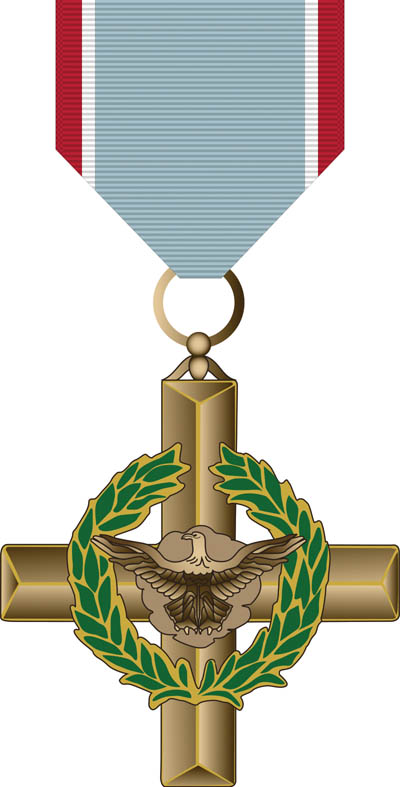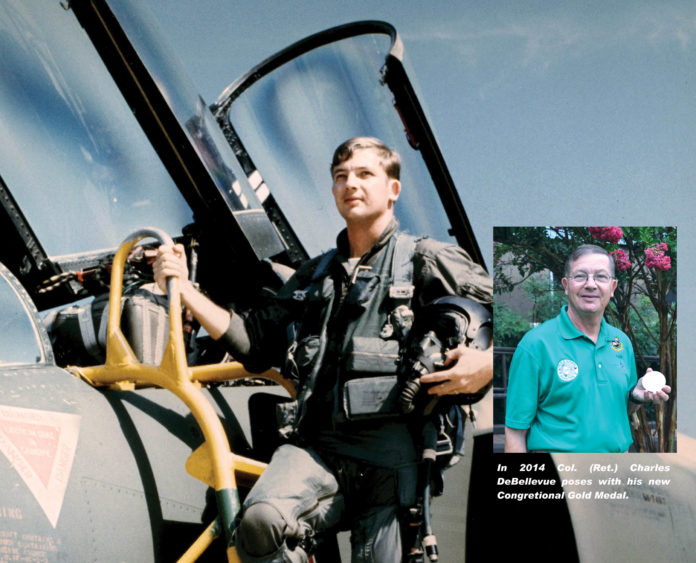story and photos by Darl Devault

Now 75 and living in Edmond, Okla., U.S. Air Force Colonel (ret.) Charles B. “Chuck” DeBellevue became America’s only ace with six MiG kills to his credit over the skies of North Vietnam as an Air Force weapons systems officer (WSO) in 1972. (story continues below)

This Veterans Day he will talk about flying the supersonic F4 Phantom at the rededication of the Midwest City High School Vietnam Veterans Memorial at 1 p.m. November 11 at the high school at 213 West Elm. America’s top ace of the Vietnam War, he is also the last ace to serve on active duty.
“It is an honor to speak at this rededication as I salute the men and women who have served,” DeBellevue said recently, “especially those who served in the Vietnam War, and those who currently serve and now sacrifice daily to keep our proud country free.”
This Veterans Day he was scheduled to be the grand marshal at the Welcome Home Vietnam Veterans! themed-parade at 10 a.m. Nov. 11 in Midwest City. Although the parade has been cancelled due to health precautions, DeBellevue will be featured at other veterans-related events. America’s top ace of the Vietnam War, he is also the last ace to serve on active duty.
“It was to have been an honor to be grand marshal at this parade as I saluted the men and women who have served,” DeBellevue said recently, “especially those who served in the Vietnam War, and those who currently serve and now sacrifice daily to keep our proud country free.”
An ace is defined as an aviator who has shot down at least five enemy aircraft in air-to-air combat. The Air Force and the Navy awarded equal credit to both the pilot and WSO in the F-4D Phantom II since they worked in tandem in two different cockpits.
Between May and September of 1972, DeBellevue shot down six enemy MiGs while flying with two different pilots in four separate engagements.
DeBellevue remembers the excellent ground support when he flew his F-4 from Udorn Royal Thai Air Force Base during the Vietnam War. The maintenance and munitions crews and the support from other base personnel helped him survive many dangerous missions.
“I knew that I had the best support in the world,” he says. “Anytime I can repay that support, I’m there.”
He was raised in Crowley, La., a small town in the middle of rice-growing country in the southwest section of the state. In 1968 he was commissioned through the Reserve Officer Training Corps at the University of Southwestern Louisiana, now the University of Louisiana-Lafayette (the Ragin Cajuns).
Getting commissioned and graduating at the same time, DeBellevue skipped graduation. The colonel who spoke at his commissioning ceremony left the new officers with an ominous statement: “May you serve in interesting times!” How true those words proved for the future ace.
Area residents in and around Tinker Air Force Base have some understanding of DeBellevue’s role in the air war over Vietnam. Near the 552nd Air Control Wing area on the base is an EC-121 aircraft, the model that supported DeBellevue on his missions into North Vietnam. The EC-121, call sign “Disco,” is an earlier version of the Boeing E-3 Sentry AWACS aircraft used today.
The crews on the AWACS planes give crucial support for today’s fighters, providing surveillance, command and control, and communications. They feed data to fighters electronically and communicate by voice. Most of the AWACS aircraft are based at Tinker.
The USS Chicago, a U.S. Navy heavy cruiser, also provided radar support to the Air Force crews flying MiG Combat Air Patrol (MIGCAP) missions into North Vietnam. Additionally, the Navy aided in tracking and targeting the enemy during bombing missions.
By 1972, air combat over Vietnam had changed with newly sophisticated air-to-air missiles. High technology sensors provided U.S. fighters with remote targeting and data on enemy aircraft.
The pilots and WSOs of the 432nd Tactical Reconnaissance Wing (TRW) had an advantage over U.S. aircrews at other locations. Ten of the wing’s F-4D Phantoms had the new, top-secret APX-80 electronics set, known by its code-name “Combat Tree.” This highly classified system could read the “friend or foe” signals of the transponders built into the MiGs.
This was the same system that North Vietnamese ground-control intercept radar used to discriminate its aircraft from those of the Americans. Displayed on a scope in the WSO’s cockpit, Combat Tree gave the Phantoms the ability to find, identify, and fire at MiGs beyond visual range.
The North Vietnamese air defense system had more than 200 radar facilities that supplied warning and guidance for the MiGs. Combat Tree helped even out the odds for the American aircrews, who in 1972 flew into North Vietnam daily.
In the early years of the war during Operation Rolling Thunder, when the F-105 fighters were going into North Vietnam continuously, it took 100 combat missions to complete a tour. In 1972, it took a year to complete a full combat tour.
Initially, the Air Force put two pilots in the F-4, which is why there was a control stick in the back cockpit. The U.S. Navy and U.S. Marine Corp never put pilots in the rear cockpit of their F-4s except in their training squadrons. DeBellevue was well-versed in all the different systems in the F-4 and could fly the jet and refuel if needed.
His aircraft carried two electronic-warfare jamming pods on missions into North Vietnam. This gave the fighter a system of electronic counter measures that helped defeat the surface to air missiles (SAMs) fired at them. “When a SAM was fired at your aircraft, you had only one chance to react,” DeBellevue said. “If you did not see the SAM or panicked, your aircraft was destroyed.”
While there were other two-seat fighters in the Air Force, the F-4 was the first two-seat combat aircraft that employed the talents of a WSO in a multi-role environment. The fighter had a solid air-to-ground capability and when modified with Combat Tree gave the airmen air-to-air mission superiority in a dogfight. The F-4 was also used as a photo reconnaissance aircraft and as a “Wild Weasel” plane that hunted SAMs.
After graduating from navigator training, DeBellevue went to F-4 upgrade training, where he learned about flying the “Rhino.” Following F-4 training he spent 18 months in the 335th Tactical Fighter Squadron (TFS) at Seymour Johnson Air Force Base in North Carolina, where he honed his flying skills. When DeBellevue was assigned to Udorn Royal Thai Air Force Base, he was very experienced in the F-4.
He reported to the “Triple Nickel Squadron,” the 555th TFS, on Nov. 30, 1971, a time when operations over North Vietnam were halted during negotiations attempting to end the war. In late 1971 and early 1972, Americans were flying missions mostly in Laos and South Vietnam.
In spring 1972, the mission of the 432nd Tactical Reconnaissance Wing at Udorn changed to include missions into North Vietnam. The Laredo High Speed Forward Air Control (Fast FAC) mission, which had been cancelled due to high losses, was restarted. DeBellevue was in the first group of three pilots and three WSOs in the resurrected program.
The Laredo Fast FAC missions were only flown in North Vietnam in an attempt to stop the flow of munitions and supplies to the Viet Cong in South Vietnam. It became obvious to DeBellevue that only those who were very sure of themselves volunteered to join the Fast FAC program, since the missions spent long hours above North Vietnam.
“If you were shot down, the possibility of being rescued was slim,” DeBellevue said. “In combat it is the decisions you make in the blink of an eye that determines whether you live or die.” An average Fast FAC mission was four to six hours long and the planes would cycle to the tanker for refueling once or twice.
DeBellevue was flying MIGCAP missions when he was not flying Fast FAC missions. On May 10, DeBellevue and pilot Steve Ritchie were number three in a formation of four F-4s, call sign Oyster Flight. One and three were flying aircraft equipped with Combat Tree. Oyster Flight was northwest of Hanoi when they picked up MiG indications.
Since they were the first flight into North Vietnam, they started shooting. Three of the four MiG-21s went down. This was 26-year-old DeBellevue’s first kill. DeBellevue’s roommate was a backseater shot down in Oyster 01.
DeBellevue did not see any parachutes prior to the F-4 hitting the side of a hill. “We did not know it, but he ejected just prior to impact,” DeBellevue said. “In three weeks, my roommate managed to evaded capture and walk far enough south so that the rescue helicopters could get to him.”
By this time, DeBellevue, who had over 15 Laredo Fast FAC missions, was selected to be the lead WSO for the Triple Nickel’s MIGCAP formations and started transitioning out of the Fast FAC program. The average MIGCAP mission was about three hours long if it went into North Vietnam by land from the west. It was about five hours long if over the Gulf of Tonkin from the east.
When asked how much time he spent monitoring his instruments during a MIGCAP mission he replied, “85 percent of the time.” When asked how much time he spent looking outside the aircraft, he had the same reply. “You had to do everything all the time,” DeBellevue said.
When the air war resumed with the bombing in 1972, the enemy MiG total was up to 206, an all-time high. The principal matchup was between the two-seat McDonnell Douglas F-4 Phantom II and North Vietnam’s best fighter, the single pilot Mikoyan-Gurevich MiG-21. These air duels occurred during U.S. efforts to protect B-52 bomber strike forces during their time in the target area.
The MiG-21 was a close match in capability with the F-4. The latest, extremely fast MiG-21s had a gun but relied mainly on their Atoll heat-seeking missiles.
The enemy pilots usually employed hit-and-run tactics. Air Force results against the MiGs improved markedly in the last six months of America’s involvement in Vietnam. In 1972, a fusion center (call sign “Teaball”) to pull together intelligence information from all reconnaissance sources was set up at Nakhon Phanom air base in Thailand.
The main Air Force air-to-air missiles were the radar-guided AIM-7 Sparrow and the heat-seeking AIM-9 Sidewinder. The Sparrow had an effective range of more than 10 miles, compared to about two miles for the Sidewinder.
Fighters escorting the bomb-carrying aircraft never knew where the threat would come from. They normally stayed close to the planes they were protecting so as not be caught out of position during an attack.
DeBellevue’s MIGCAP missions, however, were not escorting any flight loaded with bombs. Instead, they were the blocking force preventing the MiGs from getting close to the F-4s with bombs. The MIGCAP missions had the ability to go after the MiGs wherever they were flying.
“You always had to know exactly where you were flying,” DeBellevue said. “This was especially true when the targets were in the buffer zone just south of China. You had to be on you’re A-game from the time you walked out to the jet until you landed back at Udorn.”
In September 1972, Olds Flight was sent to orbit Phuc Yen airfield, located just north of Hanoi. “This was not a very safe or sane thing to do,” DeBellevue said.
Flying with Capt. John Madden, they intercepted a MiG-21 on final for landing at Phuc Yen. While they prevented him from landing, they were not in a position to destroy the enemy fighter. Olds 03 shot down the MiG with the F-4E’s 20mm gatling gun.
As they crossed the Red River 15 miles west of Hanoi 10 minutes later, DeBellevue picked up a radar target eight miles in front of them. A few seconds later they intercepted two MiG-19s. They had to make short work of these two MiGs because they were low on fuel.
It was a hard turning close-in dog fight. They hit the first MiG with an AIM-9J, and it crashed. “The second MiG-19 was aggressive and a real threat,” DeBellevue said. “We only had a few seconds to spare when we fired the number three AIM-9J. It came off our F-4 and pulled lead on the MiG-19. The missile ended up in the MiG’s engine, causing him to crash.”
That was DeBellevue’s fifth and sixth kills making him America’s top ace in the war. He was no longer allowed to fly combat. He returned to the United States for a seven-week tour of military bases.
DeBellevue returned to Udorn and in the ensuing three weeks flew his last seven missions, none in North Vietnam. He also spent time around the base thanking everyone for supporting the war effort.
His flying record in Vietnam included 617 hours of combat and a total of 220 combat missions, 96 of which were over North Vietnam. At the end of the Vietnam War, his Triple Nickel Squadron had the highest number of MiG kills in the war.
After his combat tour, DeBellevue went to pilot training and then to the front seat of the F-4. “You had to know the rules of flying” DeBellevue said of his new status. “You didn’t always have to follow them. If you had to break a rule to save the jet, break the rule. Have your story ready when you land.”
DeBellevue says he used this same tenet while he was flying, when he had non-flying jobs, and when he worked in civilian jobs after his retirement.
He went on to accumulate more than 3,000 flight hours, including 550 combat hours. His military decorations include the Air Force Cross (making ace), three Silver Stars, three Legions of Merit, six Distinguished Flying Crosses, and 18 Air Medals.
He went on to serve as base commander at Misawa Air Base, Japan, and the air base wing commander at Edwards AFB, Calif. One of his duties at Edwards was to recover NASA space shuttles returning from orbit. His final assignment was at the University of Missouri-Columbia as the commander of the Air Force ROTC detachment. DeBellevue retired in February 1998 with 30 years of service and as the last American ace on active duty.
Following retirement DeBellevue and his wife, Sally, moved their family to Edmond when he accepted a job as a program manager with Frontier Electronic Systems in Stillwater. After turning around the program that he was responsible for, he moved on to other jobs, including one with Oklahoma State University. He now works for Performance Aircraft Services Inc., based in Grapevine, Texas. DeBellevue was inducted into the Louisiana Military Hall of Fame in 2011 and the Oklahoma Military Hall of Fame in 2012. He, along with other American aces, was awarded the Congressional Gold Medal in 2014.










